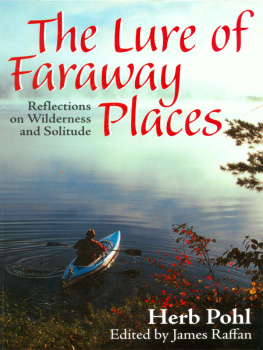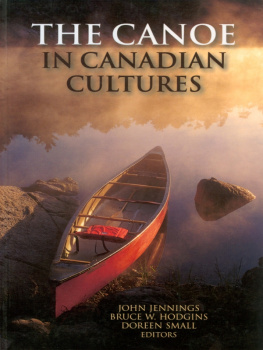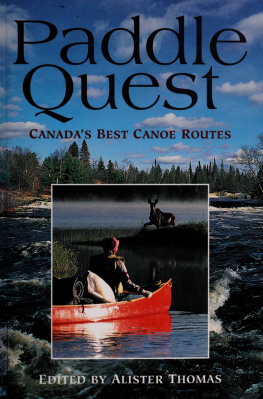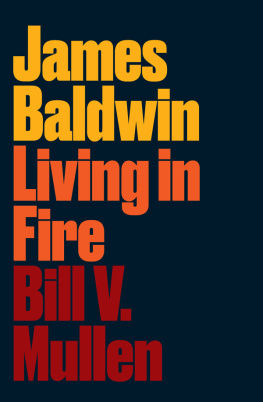FIRE IN THE
BONES
B ILL M ASON
AND THE C ANADIAN
C ANOEING T RADITION

J AMES R AFFAN

to keepers of the fire
His word was in mine heart as a burning fire shut up in my bones, and I was weary with forbearing, and I could not stay.
Jeremiah 20:9
C ONTENTS
O N A PROMISING S EPTEMBER DAY , Im searching for Bill Mason on the blue-water edge of the Canadian Shield, north of Sault Ste. Marie. Lake Superior has been calm as I have made my way west from Michipicoten Mission. The fall sun has reached its zenith and is noticeably lower in the sky than just weeks ago; my left side is hot, but theres a chill creeping in from the shadows on my right. Swells begin to rise from the direction of Devil Island or Michigan or wherever it is that the character of this lake originates. They lift and settle this canoe as if Im paddling on the back of a benevolent monster. Fortunately, the boat has been here beforeBills boat. It knows the beast. There is safety in that.
Bills widow, Joyce, has lent me this loved, old 16-foot Chestnut Prospector. The red canvas is cracked and faded. The ribs and planks are brittle. But the slat seats still squeak, and that nostalgic smell of cedar and old varnish wafts up from the sun-warmed floor as I make my way along the coast. The plan is to visit some of Bills favourite haunts. Today Im headed for Denison Falls and will sleep there in one of his old Baker tents. The boat spins as a rogue wave rolls under its keel, turning me broadside in the troughs. Its a great old canoe, but too small for a lake this size to notice. Time to head upriver. I fight to maintain balance as the waves break and tumble back in the shallow water along the sand spit that protects the river from the lake. I catch a curler and surf into the calm water on the other side.
The sign on the first inside says Dog River. Since 1632. Somebodys trying to make a point. Bill always called this river The University. He always talked about a cherished spot a couple of miles upstream from the lake: Denison Falls. He filmed it, painted it, described it in his books. Ive come along the coast to pay my respects.
Two or three bends upstream from the sign, Im debating with myself whether Im actually gaining or losing ground against the current. Should I pull a little harder and get to that eddy there, and then across to that big rock over there? Travelling alone like this, talking to myself, reminds me of Friar Tuck and the way he muddled through Sherwood Forest supplying both sides of a running argument. Bill prayed a lot when he was out here. Maybe now is the time. Or should I forgo the upstream paddling, save breaking my paddle on the bottom as I flail to make headway, and start tracking up the shore?
I tie lines to the bow and stern painter rings, let the boat angle freely into the current, coil up the loose ends and begin making my way unsteadily along the boulder bank of the river. Its not a very big river and the water appears to be low, but its surprising how much pull the canoe exerts on the ropes. Looking back at the empty red canoe, I am caught by a momentary twinge of deep sadness. Bill is gone.
The valley is deep here, and the trees are mostly birches and conifers with a few mountain ash sprinkled with vermilion berries. The forest hues are bronze, not red. Lofty hemlocks diffuse sunlight into cascades of laughing riparian light that follows me up the valley, highlighting the banks. Behind, the gulls, the noisy birds, have stayed to argue on the spit. But for the most part, the forest here is quiet. Ahead, the river chuckles away on rocks and riffles centre stream. I turn and look again at the red canoe silhouetted against the shining river, somehow expecting him to be sitting there, feet up, enjoying the free ride.
Im doing my best not to get wet feet, but before long the boat catches on a gravel bar and I must wade in, in my wellies, to move it. Three steps later Ive got one long, tall soaker; then the other. The river is not all that deep, and its not all that fast-flowing, but there is a current and the canoe feels heavy on the lines. One almighty tug, one slip, and Im wet to the waist.
Two hours later, Im thoroughly soaked, tired but pleased to be reaching a sharp left swing in the river where the map says the falls are supposed to be. I pull up the canoe by an eddy and slosh my way up the shore to catch a glimpse of this place that so caught Bills fancy. There it is, Denison Falls, running across the river, maybe 20 feet high. Im surprised. Like the man, perhaps, it looks bigger in the films.
I stripeven in an out-of-the-way place like this, its a trick to convince yourself that you are in fact aloneand carefully lay out my wet shirt, pants and red woollen socks on the smooth grey rocks to dry in the sun. Barefoot, I make my way back up the rock-strewn riverbed to the base of the falls. Theres another rushing stream coming in on the rightJimmy Cash Creek. Its almost more appealing than the big falls. Nice spot, but it is difficult to imagine why Bill got so excited about this place. Denison Falls seems pretty ordinary.
There appears to be a steep trail that starts at the point where a worn hawser dangles from an overhanging cedar tree down a vertical rock face beside the falls. I haul myself up the rock, scramble up the trail and make my way through the bushes, apparently cutting high across another sharp bend in the river. Then, suddenly, Im aware of a physical murmuring in the air and the ground around me. Under a deadfall, a few more excited steps along the path, and Ive found what Bill discovered more than thirty years ago.
The path opens to an outlook commanding a stirring view of Denison Falls. It begins above me in the coloured hills on the far side of the river, a line of black water steps out over a mist-shrouded brink; it splits with abandon on a pillar of black rock, wheels with a flick to the crowd, then bubbles itself into a filigreed fan that flutters and falls to the river below. The view suspends time, for an instant, for an hour. Bill always said he felt closer to God in places like this. Just breathing the mist-dampened air makes the transcendency of that notion close enough to touch.
Sometime later, shadows lengthen and I start to get cold. Surely those clothes arc dry by now. I return on the path, climb under the broken tree and down the steep, slippery path, onto the rope gingerlyits different trusting your life to a line when youve seen the extent of its tenuous anchor close upand back down to the river below. I pick up and pull on my jeans and shirt. Bending to get my socks, I find only one, lying flat and crispy on the rock. The other is gone. Gone. Gulls might steal a sock, but not now, not in the fall, and besides theyre probably still bickering at the lake. The only bird Ive seen all day is a circling lone osprey. The sock, apparently, has just vanished.
Its classic Mason. I start to laugh. The silliness of the missing sock is too much. For a minute Im certain that a puckish Bill is hiding in the trees somewhere nearby, with his battered hat and his favourite canoeing shirt, killing himself laughing and waving one red sock on a stick for all the otherly world to see. It was his kind of joke. Mason, you little weasel, what have you done with my sock? I call exasperatedly in a voice that is swallowed without echo by the autumnal woods.
And so it has been for nearly two years now looking for Bill Mason, checking out his favourite spots, talking to his friends and family, following his trail from one side of the country to the other. Writing the story of his life has been a little like the Denison Falls trip, hoping chance and serendipity might leaven safe, scholarly instincts. Bills geographic lifeline links Winnipeg, where he was born, to Old Chelsea, Quebec, where he died. Ive found it helpful to think of his life as a gradual eastward movement, over time, away from Winnipeg, east past Lake of the Woods, Quetico, the north shore of Superior, and Algonquin Park, to Ottawa. His career rises gradually along that line through the making of
Next page











